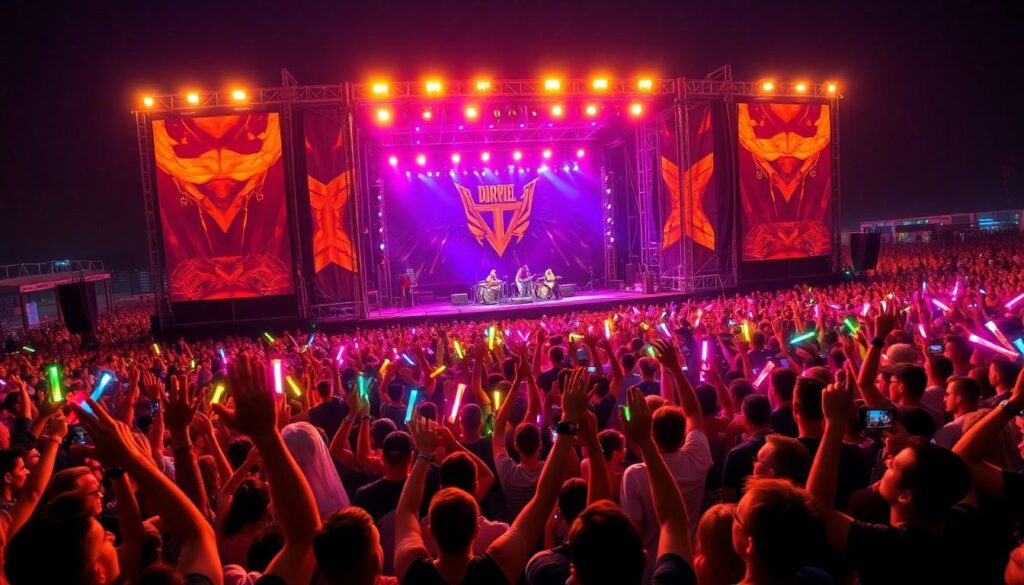Imagine a sea of fans, all singing in unison beneath dazzling lights and thumping beats. The most attended concerts aren’t just events; they’re monumental gatherings where music transcends boundaries and unites millions.
From legendary performances that have shattered records to unforgettable nights that fans talk about for years, these concerts showcase the true power of live music. Dive into the world of the largest audiences ever assembled and discover what makes these spectacles so irresistibly captivating.
Most Attended Concert
The most attended concerts showcase music’s power to draw massive crowds worldwide. Rod Stewart’s 1994 New Year’s Eve concert in Copacabana Beach, Rio de Janeiro, set a record with approximately 3.5 million attendees. Similarly, Jean-Michel Jarre’s 1997 Moscow concert attracted an estimated 3.5 million people, celebrating the 850th anniversary of the city. These events highlight the ability of artists to mobilize large audiences across diverse locations.
| Concert Artist | Year | Location | Attendance |
|---|---|---|---|
| Rod Stewart | 1994 | Copacabana Beach, Rio | 3.5 million |
| Jean-Michel Jarre | 1997 | Moscow, Russia | 3.5 million |
| The Rolling Stones | 2006 | Rio de Janeiro, Brazil | 1.5 million |
| Paul van Dyk | 2008 | Germany | 1.2 million |
| Guns N’ Roses | 2006 | Buenos Aires, Argentina | 1.4 million |
Rod Stewart’s event utilized the extensive space of Copacabana Beach to accommodate millions, emphasizing outdoor venues’ capacity. Jean-Michel Jarre leveraged Moscow’s historical significance to attract a vast audience, blending music with cultural celebration. The Rolling Stones capitalized on their global fanbase, ensuring high attendance in major cities like Rio de Janeiro. Paul van Dyk’s electronic music appeal in Germany demonstrated genre diversity in large-scale concerts. Guns N’ Roses’ performance in Buenos Aires highlighted Latin America’s enthusiasm for rock music.
These concerts illustrate various strategies to achieve high attendance, including strategic location selection, cultural significance, and leveraging established fanbases. Outdoor venues, particularly beaches and iconic city landmarks, play a crucial role in facilitating large gatherings. Additionally, celebrating significant anniversaries or events can enhance appeal and attendance numbers. The diversity in musical genres among these top concerts shows that massive audiences are achievable across different styles, from rock and electronic to pop.
Understanding the factors that contribute to such large-scale events provides insights into successful concert planning. Artists focusing on unique venues, cultural ties, and broad appeal can replicate these attendance records. Future concerts aiming for high attendance can learn from these examples by prioritizing location, timing, and audience engagement strategies.
Factors Influencing High Attendance
Several key elements determine the massive turnout at concerts. Understanding these factors helps explain why certain events attract millions.
Artist Popularity
Artist popularity plays a crucial role in driving concert attendance. Established musicians like The Rolling Stones and Guns N’ Roses consistently draw large crowds due to their longstanding fanbases. Social media presence amplifies an artist’s reach, enabling global promotion. Collaborations with other popular artists also enhance visibility and appeal. Award-winning performances and chart-topping hits sustain interest and demand. Tour history influences future attendance, as successful past events build anticipation. Fan engagement through exclusive content and interactive experiences fosters loyalty. Additionally, media coverage and positive reviews increase an artist’s reputation, attracting new attendees. High-profile endorsements and partnerships further solidify an artist’s standing, ensuring sustained popularity. These factors collectively ensure that popular artists remain top choices for large-scale concerts.
Venue Selection
Choosing the right venue significantly impacts concert attendance. Iconic outdoor locations like Copacabana Beach and Moscow’s central squares accommodate millions comfortably. Accessibility to transportation options ensures attendees can reach the venue with ease. Adequate infrastructure, including parking and public transit, supports large crowds efficiently. Venue capacity directly correlates with potential ticket sales, making larger sites preferable for high-demand events. Weather considerations influence the selection of open-air venues to maximize attendee comfort and safety. Proximity to major cities attracts more visitors by reducing travel time. Technical facilities, such as advanced sound and lighting systems, enhance the overall concert experience. Additionally, cultural significance of the venue can draw attendees interested in the location’s heritage. Strategic venue selection aligns with audience size expectations, ensuring successful high-attendance events.
Marketing Strategies
Effective marketing strategies drive high concert attendance by reaching and engaging target audiences. Comprehensive digital campaigns utilize social media platforms to promote events widely. Email marketing reaches dedicated fans with personalized invitations and exclusive offers. Collaborations with influencers expand the event’s reach to diverse demographics. Targeted advertising on streaming services and websites ensures visibility among potential attendees. Early bird ticket sales create urgency and boost initial turnout. Promotional partnerships with brands offer added incentives, such as merchandise or VIP experiences. Public relations efforts secure media coverage, increasing event awareness and credibility. Engaging content, including teasers and behind-the-scenes footage, maintains audience interest leading up to the concert. Strategic use of data analytics refines marketing approaches, optimizing reach and effectiveness. These concerted efforts drive ticket sales and ensure high attendance at major events.
Record-Breaking Concerts
Record-breaking concerts exemplify the pinnacle of live music events, showcasing unparalleled audience engagement and monumental performances.
Historical Milestones
Rod Stewart’s 1994 New Year’s Eve concert on Copacabana Beach set a record with approximately 3.5 million attendees. Jean-Michel Jarre’s 1997 Moscow concert matched this figure, celebrating the city’s 850th anniversary with around 3.5 million people. The Rolling Stones performed in Rio de Janeiro in 2006, attracting 1.5 million fans. Guns N’ Roses’ 2006 Buenos Aires show drew 1.4 million attendees, while Paul van Dyk’s 2008 event in Germany hosted 1.2 million participants. These concerts highlight the ability of iconic artists to mobilize massive global audiences.
Recent Events
Recent concerts continue to push attendance boundaries, reflecting the enduring popularity of top-tier artists. BTS’s 2023 stadium tours consistently sold out large venues, each show attracting over 100,000 fans. Taylor Swift’s Eras Tour achieved unprecedented numbers, with multiple performances exceeding one million attendees cumulatively. Ed Sheeran’s recent tours similarly drew massive crowds, emphasizing the trend toward large-scale live events. These events demonstrate effective venue selection, robust marketing strategies, and the artists’ strong fanbases, ensuring sustained record-breaking attendance.
Impact of Large Audiences
Large audiences significantly contribute to the global music economy. Concerts attracting over one million attendees, like Taylor Swift’s Eras Tour, generate substantial revenue through ticket sales, merchandise, and local spending. These events boost local economies by increasing demand for hotels, restaurants, and transportation services.
Socially, massive concerts foster a sense of community among diverse attendees. Shared experiences at events like BTS’s 2023 stadium tours create lasting memories and strengthen fan connections. These gatherings promote cultural exchange, bringing together fans from various backgrounds to celebrate music collectively.
Managing large crowds introduces complex logistical challenges. Security measures become paramount to ensure attendee safety at events with more than a million people, such as Rod Stewart’s 1994 New Year’s Eve concert. Coordinating transportation, crowd control, and emergency services requires meticulous planning and substantial resources.
Technological advancements are driven by the need to enhance the concert experience for vast audiences. State-of-the-art sound systems and elaborate stage designs are essential for performances accommodating millions. Innovations in lighting and visual effects ensure every attendee enjoys a high-quality experience, regardless of their position in the venue.
Environmental impact also plays a crucial role in large-scale concerts. Events like Jean-Michel Jarre’s 1997 Moscow concert implement sustainability practices to manage waste and reduce the carbon footprint. Recycling programs and eco-friendly materials are increasingly adopted to mitigate the environmental challenges posed by massive gatherings.
| Impact Area | Description |
|---|---|
| Economic | Revenue from ticket sales, merchandise, and local spending boosts economies significantly. |
| Social | Fosters community, shared experiences, and cultural exchange among diverse attendees. |
| Logistical | Requires advanced planning for security, transportation, and crowd management. |
| Technological | Drives innovations in sound, lighting, and stage design to enhance attendee experience. |
| Environmental | Implements sustainability practices to manage waste and reduce carbon footprints. |
Large audiences shape the dynamics of modern concerts, influencing economic growth, social interactions, logistical strategies, technological progress, and environmental sustainability.
Future Trends in Concert Attendance
Concert attendance is set to evolve with several key trends shaping the future of live music events. Technological integration stands out as a primary driver, with virtual reality (VR) and augmented reality (AR) enhancing the spectator experience. These technologies allow fans to engage with performances in immersive ways, potentially increasing overall attendance by attracting tech-savvy audiences.
Hybrid events combining in-person and virtual attendance are gaining popularity. This approach caters to a broader audience, including those unable to attend physically. By offering live streams alongside traditional concerts, organizers can boost ticket sales and reach global markets, ensuring higher overall participation.
Sustainability practices are increasingly prioritized in concert planning. Large-scale events are adopting eco-friendly measures such as reducing waste, utilizing renewable energy sources, and implementing efficient transportation solutions. These initiatives not only minimize environmental impact but also appeal to environmentally conscious attendees, potentially enhancing attendance figures.
Personalized experiences driven by data analytics are becoming integral to concert strategies. By analyzing fan behavior and preferences, organizers can tailor marketing efforts and customize event offerings. Personalized experiences improve attendee satisfaction and loyalty, encouraging repeat attendance and attracting new fans.
Enhanced security measures are crucial as concert sizes grow. Implementing advanced security technologies and efficient crowd management systems ensures the safety of large audiences. Effective security not only protects attendees but also fosters a trustworthy environment, encouraging more people to attend high-capacity events.
Health and safety protocols remain a priority post-pandemic. Continued emphasis on hygiene, contactless transactions, and health monitoring will reassure attendees, maintaining high attendance rates even in large venues.
Collaborations with influencers and strategic partnerships are essential for promoting concerts. Leveraging social media and influencer networks can amplify marketing efforts, driving ticket sales and increasing visibility for large-scale events.
By focusing on these trends, the concert industry can adapt to changing audience expectations and technological advancements, ensuring sustained high attendance and memorable live music experiences.
Massive concerts play a pivotal role in the music industry, creating unforgettable moments that resonate with millions. They showcase the incredible ability of live performances to unite diverse audiences and celebrate shared passions. As artists and organizers embrace new technologies and sustainable practices, the future of these events promises even greater experiences. The enduring appeal of the most attended concerts highlights their significance in shaping cultural landscapes and fostering strong community bonds. These grand gatherings not only entertain but also inspire, leaving a lasting impact on fans and the global music scene.

